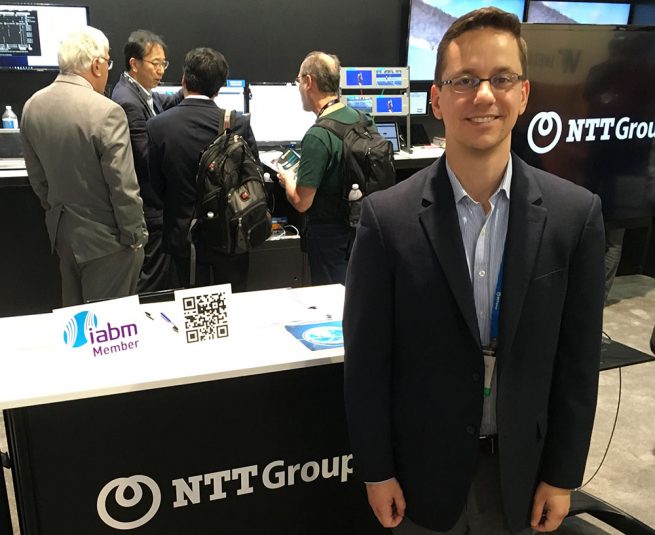NAB Reflections: NTT Electronics’ Leo Castro on the Power of HEVC, Future of 4K and HDR
Encoding demos offer 4K for the sports market, target at-home production
NTT Electronics showcased a variety of encoding/decoding technologies at NAB 2017, and, not surprisingly, much of the focus was on 4K, HDR, and HEVC. Among the offerings was the HC11000 Series 4:2:2 10-bit H.265/HEVC real-time encoder, which has the capability to transmit high-quality video images at low bitrate, low latency, and low power consumption. Scalable, it handles SD to HD and to 4K/60p. Also on display was NTT Group’s Smart Contribution Solution for at-home production, which provides multiple video-stream transmissions from venue to broadcasting center with a cost-effective, secure, and managed mechanism. In addition, NTT TechnoCross’s viaPlatz 4K/8K scalable video-server system and a real-time 4K HFR+HDR H.265/HEVC encoder were demonstrated at the booth.
SVG sat down with Leo Castro, senior sales engineer, NTT Electronics America, to discuss the products on display and R&D demos at the show, the maturation of HEVC, customer interest in 4K and HDR, and the increasing demand for at-home–production solutions in the sports market.
What is NTT highlighting at NAB 2017?
For the sports market, we’re showing HC11000 and HC10000 HEVC encoder/decoder. The demo that we’re showing is 4K/60p encoding and decoding, 4:2:2, 10-bit at 100 ms end to end. For sports contribution, we think that this is very important because the latency is very low, especially for 4K. For HD, we’re 33 ms end to end.
In addition, on the decoding side, we can receive any flavor: H.264, MPEG-2, or HEVC. On the encoding side right now, we’re just doing HEVC, but we’re planning to add AVC on the next firmware update. If you’re in an HD environment and receiving a 4K HEVC signal, you have some flexibility there. We’re trying to future-proof the product since a lot of people are not ready to jump into 4K: they can store HD or even H.264 and then later down the road upgrade to HEVC 4K.
On the R&D side, we have a 4K 120-fps demo using four different encoders in 1080p mode. We have a 60p base layer, and we also have the enhancement layer, so it is backwards-compatible. If you have a 120p TV, you can get that high frame rate, but, if you just have a 60p TV, you can get that 60p image as well.
We also have our viaPlatz 4K and 8K video-production server, which can serve a few different needs. Of course, the big thing at the show this year is HDR, and this is a great tool for HDR. There are several HDR standards, such as HLG and the PQ, and this device can work with any of those standards. So, if you’re doing SDR today and you want to upconvert to HDR, you can use this. If you’re using HLG and need to convert to PQ, you can use this software. We actually have customers that are using this live for HD right now. They ingest the camera feed, record it, color-correct live at the stadium, and send it to their studio.
Are you seeing actual requests for 4K products in North America right now, or are customers still in the exploratory phase?
In Europe, there’s more 4K activity than here. We’ve done some demos, some small applications, including customer transmission at the Olympics. But, right now, our European market is having more traffic for 4K than in North America, though we expect that to grow in the near future.
What about 1080p HDR transmission? is that something customers have been asking about in the U.S. instead of 4K?
I’ve been noticing interest in [1080p HDR] for the North American market, especially for the broadcasters. They don’t want to switch out all their equipment from HD to 4K. For production, it makes sense, but, for transmission, it’s a very large [undertaking]. Initially, I know 4K is in the plans for ATSC 3.0, but a lot of the broadcasters may just want to use 1080p and not HDR or bump the frame rate up later, rather than 4K. So that’s something we’re looking into as well.
How has customer interest in the use of HEVC grown over the past year? Do you consider it a truly mature technology at this point?
For us, every customer is interested in HEVC. Once they demo our product, they can see that this is a full-blown product ready for high-end contribution events. As far as NTT goes, we’re 100% ready. If the customer wants to start out with H.264 first and then buy a license for HEVC later, that’s fine. But everybody’s interested in reducing their bandwidth, and that makes HEVC appealing today.
Tell us a bit about the at-home production demo you have on display? How does this reflect the sports market’s demand for at-home solutions?
We have our H.264 encoders going through the ViaPlatz MTS, which is muxing three encoders and then streams it out. On the other side, you demux it and monitor the network on that side. This is great for remote production in that the encoder is very low latency: just one frame end to end. We’re adding these other solutions to monitor the network, so you can troubleshoot and find exactly where the problem is. This also communicates back with the encoder. If there’s a network issue, the encoder can change its parameters or the bitrate if necessary, so you always have a stable transmission. This is a perfect tool for people who are hesitant to use IP networks. As long as we give them the right tools to use, they can become more confident in using an IP network.
We have a couple customers that are using this already, especially since we do a lot of contribution events. This allows them to avoid sending a whole crew to [the venue] and just send all the feeds back [to the broadcast center] to do it all remotely.

